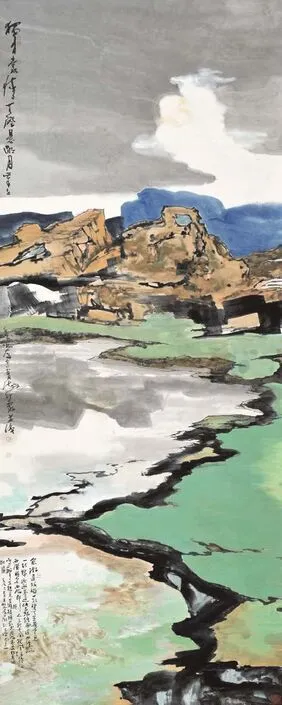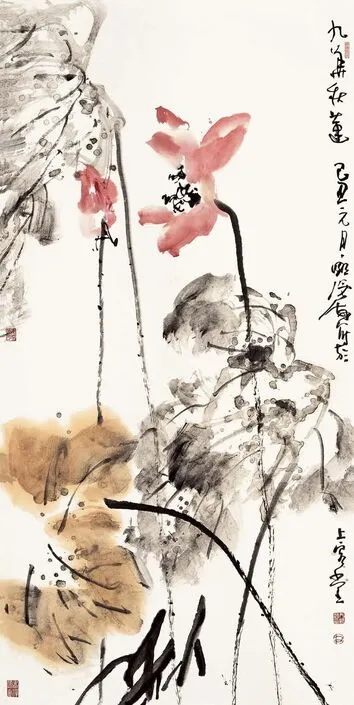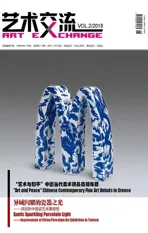境由心生,艺道并进
——尹沧海印象
2018-09-20焦俞萍JIAOYuping
文焦俞萍 JIAO Yuping

疏柳寒烟图 尹沧海Scattered willows in cold smoke YIN Canghai
唐代画家张璪谈及艺术创作时曾言:“外师造化,中得心源”;北宋画家范宽说:“前人之法未尝不近取诸物,吾与其师于人者,未若师诸物也。吾与其师于物者,未若师诸心也。”其二人可谓异曲同工地道出了中国传统绘画创作的艺术规律:外物感于心,艺术家以自己的情感、思致渗透改造物象,进行取舍、加工、升华,创作出具有独特审美风格的艺术作品。南开大学教授、天津美协副主席尹沧海就是一位强调自然,有传统修养和艺术思考以及独立审美追求的艺术家。他的中国画作品涉猎广泛,涵盖人物、山水、花鸟三个大领域,涉及现实人物、佛道鞍马、神灵怪异、名山大川、仙山琼阁、异域风光、花鸟虫鱼、果蔬案头、祥禽瑞兽等众多题材。作大幅山水风格气势恢宏;作人物、花鸟多见性情。作品笔墨精湛,注重书画之一律,“密体”“疏体”“工笔”等诸法皆备,格调纯正、天真自然,而又体现出画中有诗、禅境入画的审美意趣,抒发着于现实之外恬淡、安然之心境。
诗意的栖居
对于诗画之交融,尹沧海认为:“禅宗的所谓‘见性’以及以庄子为代表的道家思想以审美的态度追求的天人合一与儒家之互补,是诗画交融的哲学根基。中国人独特的美学观念和审美趣味,经过千百年文人画家的创作实践,文人画最终具有强烈的移情性,以书为骨,以诗为魂,直指内心。”观尹沧海的画作,《疏柳寒烟图》《远岸依稀初月明》《闲听鱼读月》等作品,画境幽深而不晦涩,笔墨简逸而从容自然,充满勃勃生意,画中常有陶渊明的恬淡自然、李白与苏轼的豪迈大气;而有时那几笔铮铮骨法的勾勒,透露出杜甫“沉郁顿挫”之风骨。他的笔下,常蕴有诗人的文韵:“东风不解语,何故乱我心”“秋水无波鱼自如”“月明午夜生虚籁”……透露出浓浓的画意与诗情。
“自然”是中国绘画的核心美学追求。“自然”一则有“自然而然”之意,要求绘画创作要尽可能的消解人为做作痕迹;二则有“师造化”之意,强调画家要深入自然,体察自然之本真。“自然”的美学追求与老庄哲学的“自然”概念以及魏晋玄学的“自然”观有着直接的思想联系。一言以蔽之,即是用一种具有“淡”“拙”“朴”美感的笔墨表现天地自然之本真。
对“自然”之亲近,也是尹沧海中国画创作的重要特征。他说:“画家在其进入创作状态之前不仅要理性地、体察入微地观察所要描绘的物象的丰富性,同时更重要的还应该被自然之‘大美’的和谐秩序所感动。”他对自然的体察,是“以诗人之眼观物”,是谓“登山则情满于山,观海则意溢于海”,泼墨挥毫间寄托着他对田园自然逸趣的向往,他以天真自然之笔,为自己找到诗意的栖居之所。

独有豪情 尹沧海Unique Confidence YIN Canghai
无法而法
中国绘画艺术的创作尤为重视生活的真实感受。尹沧海认为:“生活感受包括‘感受——感知——觉悟’,它不是面对生活素材不加思索,不去用心领悟,就能凭空生发的。不然,纵使‘众里寻他千百度’,也难以获取。这其中包含‘亲见’与体验,包含着回忆与思索,更包含着长期的思想的、生活的、知识的积累。”正是在这种对于生活实感的反观与沉淀中,画家将原本琐碎、繁杂、无序的个体情绪,加以凝练化与秩序化,构成了足以孕育创作实践的艺术个性。
自我生命体验的自由表达是中国绘画“写意性”的旨要所在,但是这种自由表达并非是笔墨的胡涂乱抹,画家主体状态的洋溢仍需依据并借助法则与秩序。尹沧海认为,辩证地认识、处理自然秩序与艺术秩序的关系是极为重要的一个方面。“掌握自然之理论与知识,对于绘画过程来讲是必要的。但是有了这些理性知识,并不等于我们就能够画好一幅画,重要的是在作画时以‘坐忘’‘离形’‘去智’的非分解性、概念性的纯知觉活动,对于自然之理进行化解与融通。在这样创作状态下所传达的艺术精神,虽然是一己的个性表现,却能够直达物象本质,因而,也就体现了自然之秩序,并表达了艺术秩序。”他说。
谈到写意花鸟画与禅宗写意画的关系,尹沧海表示,禅宗的“自用智慧常观照故,不假文字”,如老庄“道法自然”“复归于婴儿”一样,都是旨在讲述人的自然本性回归的途径,而写意花鸟画自身的自然性的特点,首先要求写意画家回归到自心,回归到万物齐一的境界。尹沧海的书画作品都表现出禅宗写意之风。他的《达摩面壁图》《形容出造化 想象成天地一荷花翠鸟》《空山无人 水流花开》《莫谓无心便是道》《莫道山中岁月长》《心闲便是神仙》等作品,以禅宗写意画的精神、形式、语言为特点,笔势飞扬的同时把握墨色的韵致,自由挥洒中编织出一个寂静淡雅的水墨艺术世界。
When the artist of the Tang dynasty ZHANG Zao talked about artistic creation,he once said: "Stemming from natural environment, arts are created by artists’ inner minds". The Northern Song dynasty painter FAN Kuan also said: "The method for painting landscape of predecessors is by observing environment.Rather than learning from them, I should observe the landscape carefully. Rather than observation, I had better choose the technique and genre I prefer. " The two artists have stated the artistic rules of China’s traditional creation of painting through different means: the artist infiltrates and transforms objects with his own emotions and thoughts,creating artistic works with unique aesthetic styles through selecting, processing and sublimating. YIN Canghai, professor of Nankai University and vice-chairman of the Tianjin Artists Association, is an artist who emphasizes nature with traditional cultivation, artistic thinking and independent aesthetic pursuit. His Chinese paintings cover a wide range of subjects, including characters, landscapes, flowers and birds, involving people, Buddhist and pommel horses, deities, famous mountains and rivers, holy mountains and pavilions, exotic scenery, flowers, birds and fish,fruit and vegetable, the benevolent and many other topics out of the real life. His large landscape style paintings were magnificent while featuring genuine temperament in paintings about characters, flowers and birds. The works are exquisite in writing and focusing on paintings and calligraphy especially in the form of "compact body", "dispelling body" and "work brush". The style of YIN is pure, innocent and natural, while embodying the aesthetic interest of poetry and Zen-style in the painting,presenting sound and safe mood out of the reality.

九华秋莲 尹沧海Autumn lotus in Jiuhua Mountain YIN Canghai
Poetic Dwelling
For the blending of poetry and painting, YIN Canghai believes:"The so-called 'seeing nature’ of Zen Buddhism and the Taoist ideas represented by Zhuang Zi’s pursuit of the aesthetic attitude to the harmony between man and nature complement the Confucianism, which is the philosophical foundation for the blending of poetry and painting. The Chinese people's unique aesthetic concepts and tastes, after thousands of years of literary artist's creative practice, showcase strong empathy in term of the literati paintings, with the calligraphy as the bone and the poems as the soul, pointing straight to people’s heart."Viewing the paintings of YIN Canghai,Smoke in Winter,Admiring Crescent in Distance, Fish and Moonand other works are deep but not obscure with simple and natural brushwork, full of vitality. His paintings often illustrate the bleak atmosphere of TAO Yuanming, splendid ambition of LI Bai and SU Shi, and sometimes the sketches reveal the strong character of DU Fu's"sudden frustration". The rhyme of the poets is often shown by his brushes: "Inexplicable east wind disturbs my heart" "Free fish under calm water in autumn" and "The moonlight brightens at midnight."…revealing thick painting and poetic feelings.
"Natural" is the core aesthetic pursuit of Chinese painting."Natural", on one hand, has the meaning of "by the light of nature", requiring paintings to be as free as possible of artificial traces. On the other hand, there is the intention of "learning from the nature", emphasizing that the painters must get close to the nature and observe its genuineness. The aesthetic pursuit of "natural" has a direct connection with the concept of "nature"of Lao Zi and Zhuang Zi’s philosophy and that of metaphysics of Wei and Jin dynasties. In a word, it expresses the true nature of the natural world with the brushwork of "light", "clumsy" and"honest".
The closeness to "nature" is also an important feature of Yin Canghai's Chinese painting creation. He said: "The artist must not only observe the abundance of the objects to be depicted before he enters the creative state in a rational and physical manner,but at the same time he should be moved by the harmonious order of the ‘natural beauty’." His observation of nature is "a poet's perspective of the object", which means "Emotion is embedded in nature", and the splashing brushwork entrusts his enthusiasm for the pastoral nature as the painter uses the brush of innocence and nature to find himself a poetic dwelling.
Taoist Nature
The creation of Chinese painting art pays special attention to the true feelings of ordinary life. YIN Canghai believes: "Sensations of life include 'feelings-preservation-consciousness', which cannot occur without unhesitating thinking of materials of life or understanding by heart. Otherwise, even if 'looking for it forever’, it’s hard to find. It includes 'visiting' and experience,containing memories and reflections, but also long-term accumulation of ideas, life and knowledge." It is in this reflection and precipitation of a sense of real life that the artist condenses and regularizes the individual emotions that were originally trivial, complicated and unordered, and constitutes an artistic personality sufficient to cradle the creative practice.
The free expression of self-life experience is the purpose of"freehand" of the Chinese painting, but this free expression is not a mess of ink and brush, and the overflow of the painter’s subject status still requires relying on rules and orders. According to YIN Canghai, understanding and dealing with the relationship between natural and artistic order is an extremely important aspect in the dialectical manner. He said: "Grasping the theory and knowledge of nature is necessary for the painting process.However, with this rational knowledge in hand, it does not indicate that we can draw a good picture. What is important is that, during painting process, the non-decomposing and conceptual and pure consciousness of activities as 'sit still','deformation' and 'de-intelligence' resolve and integrate nature's principles. The artistic spirit conveyed in this state of creation,although a manifestation of one's own personality, is able to directly reach the nature of the object, hence, it also reflects the order of nature and expresses the artistic order. "
Upon talking about the relationship between freehand brushwork of flower and bird and Zen freehand paintings, YIN Canghai stated that Zen's "Without reminding words, he uses wisdom to observe himself to reach the realm", and Lao Zi and Zhuang Zi’s "Taoist Nature" and "Return to Baby Status" are all intended to tell about the ways for human being to return to natural status. And the natural characteristic of freehand flower and bird painting, first of all, requires artists of freehand painting to return to their own hearts and the originality of all issues. YIN Canghai's paintings and calligraphy all showcase the Zen style of freehand brushwork. HisBodhidharma Facing The Wall, Lotus and Birds, Empty Landscape with Flowing Water and Flowers,All About Ways, All About Time,God with Free Heartand other works, characterized by the spirit, form and language of Zenstyle paintings, feature flying strokes while grasping the charm of ink, depict a silent and elegant art-world of ink based upon freedom.
